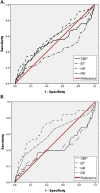Triage vital signs predict in-hospital mortality among emergency department patients with acute poisoning: a case control study
- PMID: 22900613
- PMCID: PMC3459725
- DOI: 10.1186/1472-6963-12-262
Triage vital signs predict in-hospital mortality among emergency department patients with acute poisoning: a case control study
Abstract
Background: To document the relationship between triage vital signs and in-hospital mortality among emergency department (ED) patients with acute poisoning.
Methods: Poisoning patients who admitted to our emergency department during the study period were enrolled. Patient's demographic data were collected and odds ratios (OR) of triage vital signs to in-hospital mortality were assessed. Receiver operating characteristic curve was used to determine the proper cut-off value of vital signs that predict in-hospital mortality. Logistic regression analysis was performed to test the association of in-hospital mortality and vital signs after adjusting for different variables.
Results: 997 acute poisoning patients were enrolled, with 70 fatal cases (6.7%). A J-shaped relationship was found between triage vital signs and in-hospital mortality. ED triage vital signs exceed cut-off values independently predict in-hospital mortality after adjusting for variables were as follow: body temperature <36 or >37°C, p < 0.01, OR = 2.8; systolic blood pressure <100 or >150 mmHg, p < 0.01, OR: 2.5; heart rate <35 or >120 bpm, p < 0.01, OR: 3.1; respiratory rate <16 or >20 per minute, p = 0.38, OR: 1.4.
Conclusions: Triage vital signs could predict in-hospital mortality among ED patients with acute poisoning. A J-curve relationship was found between triage vital signs and in-hospital mortality. ED physicians should take note of the extreme initial vital signs in these patients.
Figures



Similar articles
-
The association between vital signs and mortality in a retrospective cohort study of an unselected emergency department population.Scand J Trauma Resusc Emerg Med. 2016 Mar 3;24:21. doi: 10.1186/s13049-016-0213-8. Scand J Trauma Resusc Emerg Med. 2016. PMID: 26940235 Free PMC article.
-
The association between vital signs and clinical outcomes in emergency department patients of different age categories.Emerg Med J. 2022 Dec;39(12):903-911. doi: 10.1136/emermed-2020-210628. Epub 2022 Jan 11. Emerg Med J. 2022. PMID: 35017189 Free PMC article.
-
End-tidal carbon dioxide measured at emergency department triage outperforms standard triage vital signs in predicting in-hospital mortality and intensive care unit admission.Acad Emerg Med. 2023 Aug;30(8):832-841. doi: 10.1111/acem.14703. Epub 2023 Mar 20. Acad Emerg Med. 2023. PMID: 36802204
-
Clinical Decision Support Systems for Triage in the Emergency Department using Intelligent Systems: a Review.Artif Intell Med. 2020 Jan;102:101762. doi: 10.1016/j.artmed.2019.101762. Epub 2019 Nov 17. Artif Intell Med. 2020. PMID: 31980099 Review.
-
Vital Signs for Pediatric Health: Infant Mortality.NAM Perspect. 2023 Jun 26;2023:10.31478/202306a. doi: 10.31478/202306a. eCollection 2023. NAM Perspect. 2023. PMID: 37916061 Free PMC article. Review. No abstract available.
Cited by
-
Trajectories of vital status parameters and risk of mortality among acute organophosphorus poisoning patients - a latent class growth analysis.BMC Public Health. 2020 Oct 12;20(1):1538. doi: 10.1186/s12889-020-09637-x. BMC Public Health. 2020. PMID: 33046064 Free PMC article.
-
The Relative Risk of Toxico-Clinical Parameters with respect to Poisoning Severity and Outcomes in Patients with Acute Poisoning.Adv Biomed Res. 2022 Nov 28;11:107. doi: 10.4103/abr.abr_290_21. eCollection 2022. Adv Biomed Res. 2022. PMID: 36660757 Free PMC article.
-
Emergency Department Vital Signs and Outcomes After Discharge.Acad Emerg Med. 2017 Jul;24(7):846-854. doi: 10.1111/acem.13194. Acad Emerg Med. 2017. PMID: 28375565 Free PMC article.
-
The value of shock index, modified shock index and age shock index to predict mortality and hospitalisation in a district level emergency centre.Afr J Emerg Med. 2023 Dec;13(4):287-292. doi: 10.1016/j.afjem.2023.09.007. Epub 2023 Sep 30. Afr J Emerg Med. 2023. PMID: 37822303 Free PMC article.
-
A four-way patient search method for the retrospective identification of poisoning patients.Sci Rep. 2024 Jan 20;14(1):1801. doi: 10.1038/s41598-024-52358-z. Sci Rep. 2024. PMID: 38245593 Free PMC article.
References
MeSH terms
LinkOut - more resources
Full Text Sources

